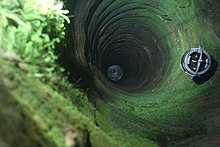Königstein Fortress
The 9.5-hectare (23-acre) rock plateau rises 240 metres (790 ft) above the Elbe and has over 50 buildings, some over 400 years old, that bear witness to the military and civilian life in the fortress.By far the oldest written record of a castle on the Königstein is found in a deed by King Wenceslas I of Bohemia dating to the year 1233, in which a witness is named as "Burgrave Gebhard of Stein".Its first full description as Königstein ("King's Rock") occurred in the Upper Lusatian Border Charter (Oberlausitzer Grenzurkunde) of 1241, that Wenceslas I "in lapide regis" (Lat.In this charter the demarcation of the border between the Slavic Gauen of Milska (Upper Lusatia), Nisani (Meißen Depression) and Dacena (Tetschen region) was laid down.It belonged at that time to the Kingdom of Bohemia and was expanded by order of the Bohemian kings, as the Elbe became more intensively used as a trade route, into a fortified site that dominated the north of their territories, controlling the Elbe above Pirna, and an outpost of strategically important Dohna Castle located in the nearby Müglitz.After the king and later emperor, Charles IV had Eulau Castle, which dominated the southern region, destroyed in 1348 by townsfolk from Aussig, he spent from 5 to 19 August 1359 on the Königstein and signed the authority for shipping rights.But not until 25 April 1459 was the transfer of the castle to the Margraviate of Meißen finally completed once the Saxon-Bohemian border had been settled in the Treaty of Eger.In 1516, Duke George the Bearded, a fierce opponent of the Reformation, founded a Celestine abbey on the Königstein, the Kloster des Lobes der Wunder Mariae.In the years 1563 to 1569 the 152.5 metre deep well was bored into the rock within the castle - until that point the garrison of the Königstein had to obtain water from cisterns and by collecting rainwater.The Saxon Dukes and Prince-Electors used the fortress primarily as a secure refuge during times of war, as a hunting lodge and maison de plaisance, but also as a dreaded state prison.[4] Around 1756, Elector Augustus III commissioned the Italian artist Bernardo Bellotto to paint a series of five large-scale views of the fortress at Königstein.The fifth canvas, The Fortress of Königstein from the North-West, is now in the United States, on display in the National Gallery of Art in Washington D.C.[5][6] In Anthony Trollope's novel Phineas Redux, it is during an excursion to Königstein, "the fortress constructed on that wonderful rock," that the hero, Phineas Finn, learns from his first love, who had refused his offer of marriage, that she had in fact always loved him, and continues to.












GermanBastillefortressDresdenSaxon SwitzerlandGermanyKönigsteinRiver Elbefortificationstable hill of the same nameplateausandstoneprisonSaxonytouristLiliensteinBernardo BellottoWenceslas I of BohemiaKingdomBohemiaBishopric of MeissenUpper LusatiaKingdom of BohemiaDohna CastleMüglitzCharles IVAussigDohna FeudMargraviate of MeißenTreaty of EgermilitarymonasteryGeorge the Beardedthe ReformationCelestineEvangelicalPrince-ElectorChristian I of SaxonyfortificationAugust the StrongGerman EmpireWittenbergZwingerQuarter cannonHistory of Saxonyhunting lodgemaison de plaisanceFrederick Augustus IISeven Years' Warhis armyPrussian ArmyKrietzschwitzBattle of KulmBattle of LeipzigSecond World Warcasemateschimney sweepSaxon systemFranco-Prussian Warworld warsprisoner of war campWorld War IofficersWorld War IIOflag IV-BCrypto-CalvinistsCaspar PeucerNikolaus KrellElectorate of SaxonyFranz Conrad RomanusBürgermeisterLeipzigJohann Friedrich BöttgerTschirnhausJohann Reinhold von PatkulLivonianKarl Heinrich von HoymMikhail BakuninRussiananarchistAugust Bebelsocial democracyThomas Theodor HeineFrank WedekindHenri GiraudBertrand FagaldeBattle of DunkirkBundeswehr Military History MuseumGreat BritainNational GalleryKnowsley HallManchester Art GalleryNational Gallery of ArtWashington D.C.Phineas Redux